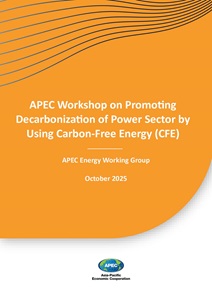
Proceedings
APEC Workshop on Promoting Decarbonization of Power Sector by Using Carbon-Free Energy (CFE)
The Asia-Pacific Economic Cooperation (APEC) is a regional economic forum established in 1989 to leverage the growing interdependence of the Asia-Pacific.
The Asia-Pacific Economic Cooperation (APEC) is a regional economic forum established in 1989 to leverage the growing interdependence of the Asia-Pacific.
APEC ensures that goods, services, investment and people move easily across borders. Members facilitate this trade through faster customs procedures at borders; more favorable business climates behind the border; and aligning regulations and standards across the region.
APEC ensures that goods, services, investment and people move easily across borders. Members facilitate this trade through faster customs procedures at borders; more favorable business climates behind the border; and aligning regulations and standards across the region.
APEC works to help all residents of the Asia-Pacific participate in the growing economy.
APEC works to help all residents of the Asia-Pacific participate in the growing economy.
Capacity building projects play an important role in helping translate APEC's goals into reality.
Capacity building projects play an important role in helping translate APEC's goals into reality.

Reports
•August 2018
Download Report
4MB
Published Under
APEC Secretariat, APEC Policy Support Unit
Accessed
16735
Pages
105
Structural reform is the oil that makes the engine of the economy run efficiently. It removes barriers to economic participation, encourages competition, and improves institutions among others. The Renewed APEC Agenda for Structural Reform (RAASR) was set forth by APEC’s Structural Reform Ministers in 2015 to consolidate and streamline APEC’s structural reform work and build on progress as well as lessons learnt under LAISR and ANSSR. This RAASR mid-term review report was prepared by the PSU to assess how much progress has been attained by economies in their structural reform efforts, and identify gaps where economies may focus their attention. It comprises of two main parts: a review of APEC-wide progress using agreed external indicators, and a review of progress by individual economies.

